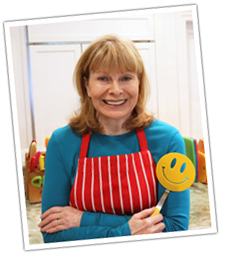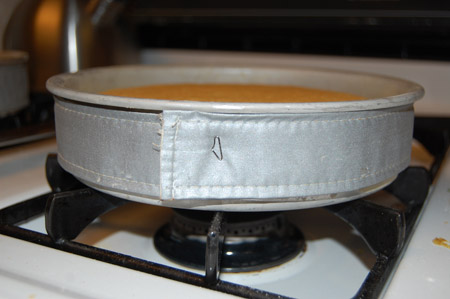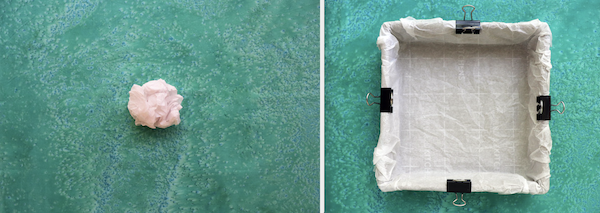
This Really Works
How To Freeze Yeast
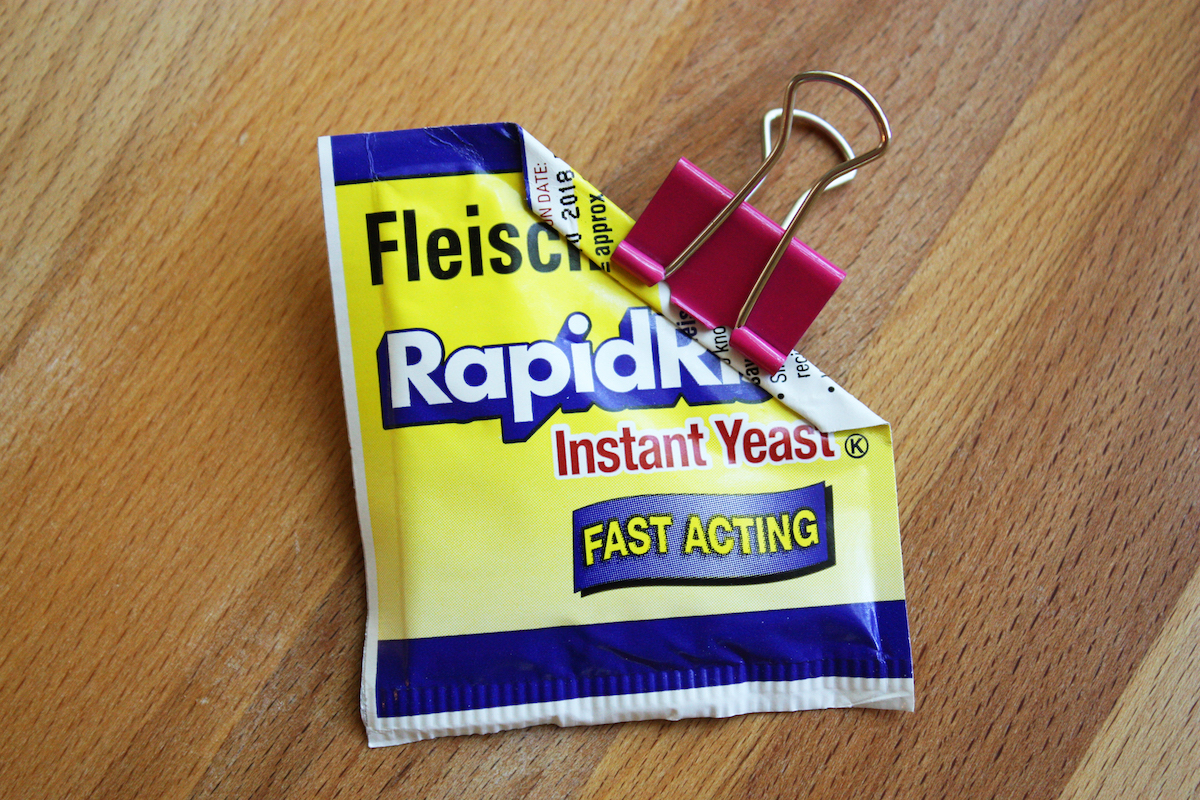 Yeast has a short shelf life and once any package of yeast has been opened, it should be kept in the freezer. I always use the small packets and I find that using a butterfly clip, the kind you can get at an office supply store, is a good way to seal up the packet for freezing. A paper clip would also work. I snip off the corner of the packet, measure what I need, fold the open corner over twice and seal it with the clip. Then I pop it in the freezer. – Jenny Jones
Yeast has a short shelf life and once any package of yeast has been opened, it should be kept in the freezer. I always use the small packets and I find that using a butterfly clip, the kind you can get at an office supply store, is a good way to seal up the packet for freezing. A paper clip would also work. I snip off the corner of the packet, measure what I need, fold the open corner over twice and seal it with the clip. Then I pop it in the freezer. – Jenny Jones
Flour Basics
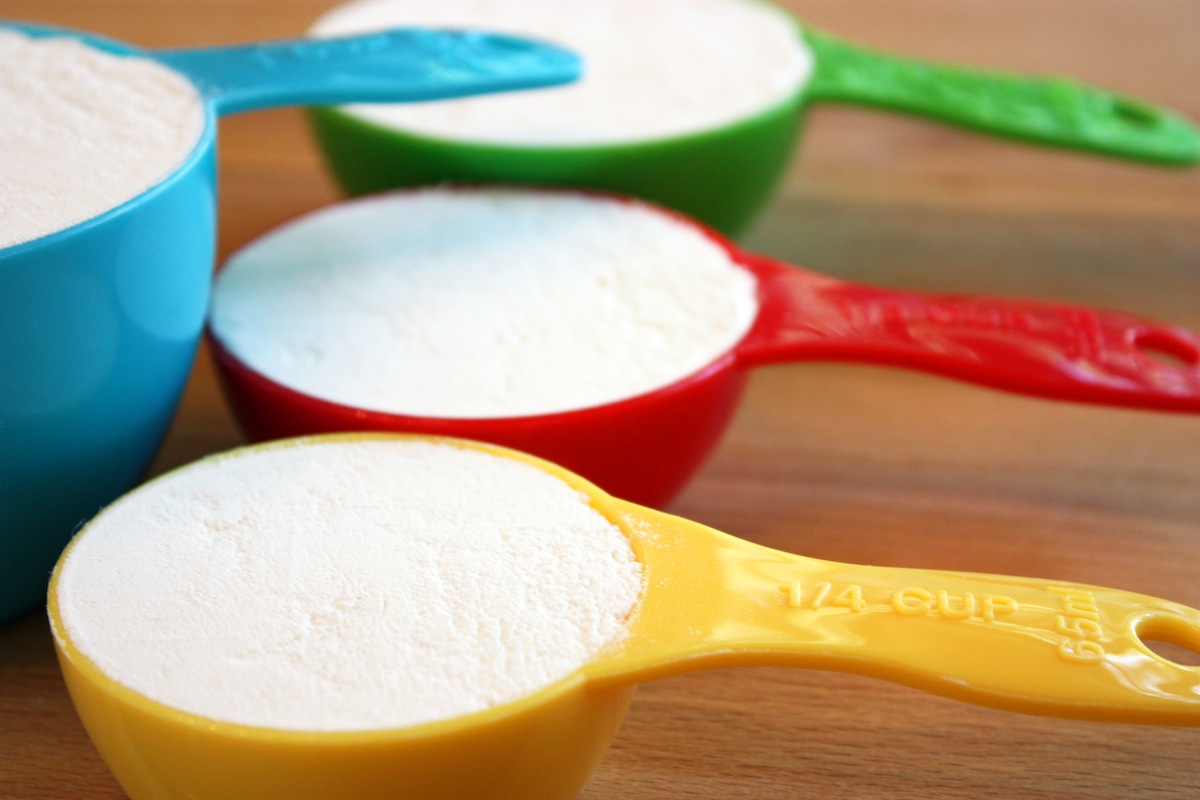 “Which flour do I use for bread, or muffins, or cookies?” “Can I substitute one flour for another?” “Why is my flour mixture so dry?” I hope this helps clarify any questions you have about flour. By the way, with all baking the amount of protein in flour matters. The lower the protein, the softer the baked goods. So here is my simple guideline to baking with flour:
“Which flour do I use for bread, or muffins, or cookies?” “Can I substitute one flour for another?” “Why is my flour mixture so dry?” I hope this helps clarify any questions you have about flour. By the way, with all baking the amount of protein in flour matters. The lower the protein, the softer the baked goods. So here is my simple guideline to baking with flour:
How to Measure (& Aerate) Flour
Flour must be aerated before measuring because it often settles in the bag or container making it heavy and compact, resulting in too much flour being measured. Aerating basically means fluffing it up and is not the same as sifting. Flour should not be sifted before measuring unless the recipe states to do so. Sifting will result in too little flour being measured.
If you dip into flour without aerating, you will be getting too much flour and your dough will be too dry. To aerate flour you simply stir it around with a spoon before measuring. To measure, be sure to use a flat-topped dry measuring cup like in my photo. To see a short video on how to aerate flour click here.
After aerating, there are two ways to measure the flour: 1) Scoop & Level – Gently scoop the flour up with a spoon and sprinkle it into your measuring cup until it’s mounded above the rim. Do not tap the cup or the container of flour. Finally, level off the excess flour with the back of a knife. 2) Dip & Level – Gently dip your measuring cup into the flour until it’s mounded above the rim and level off the excess flour with the back of a knife. In my kitchen, a cup a flour weighs 4 1/2 ounces (130 grams).
The Difference Between Flours
Whole wheat flour (about 14% protein/gluten)
Whole wheat flour is not the same as whole wheat pastry flour and should not be substituted for whole wheat pastry flour. Whole wheat flour is milled from hard winter wheat and is best used only for yeast breads. A loaf made entirely with whole wheat flour will be a dense and somewhat heavy loaf. For a softer loaf, it is often combined with some all-purpose or bread flour. Whole wheat flour is not suitable for other baking like cookies and cakes. *Since it contains the germ of the wheat which contains oil, once opened, this flour should be kept refrigerated in a tightly sealed container.
Whole wheat pastry flour (about 10% protein/gluten)
Also called whole grain pastry flour, this flour is good for most recipes that use all-purpose flour when you want to add fiber. Whole wheat pastry flour is milled from a soft summer wheat and is best for baking cookies, brownies, pancakes, waffles, quick breads, and some cakes. Results will not be as light and soft as using all-purpose flour but you can also mix part whole wheat pastry flour and part all-purpose flour for soft baked goods with added fiber. (I use this flour the most in cookies, brownies, even pancakes & waffles for extra fiber) This flour is not a good substitute for whole wheat flour and is not suitable for baking yeast breads. Don’t have whole wheat pastry flour? Regular whole wheat flour is not a good substitute – your baked goods will be dense and heavy. Look for whole wheat pastry flour at health food stores or you can order it online. Once opened, it should be kept refrigerated in a tightly-sealed container.
Bread flour (about 14% protein/gluten)
This flour is designed for yeast baking. It helps create more gluten for a better rise in yeast doughs. Use it for yeast bread and pizza dough for a chewy texture and good structure. However, all-purpose flour works almost as well with yeast. From my experience, if you don’t have bread flour, all-purpose flour can be used as a substitute in yeast bread and pizza dough.
All-purpose flour (about 10% protein/gluten)
The name says it all. Use it for cookies, cakes, quick breads, yeast breads, pies, pancakes, etc.
Pastry flour (about 9% protein/gluten)
This flour falls between all-purpose flour and cake flour and can be used in pastries, cookies and cakes. This flour is not suitable for baking yeast breads.
Cake flour (about 8% protein/gluten)
This very fine grain flour is good in light and airy cakes like angel food cake. However, if a recipe does not call for cake flour and you decide to use it, you would use more (2 tablespoons more per each cup). Conversely, if a recipe calls for cake flour and you don’t have it, you can make your own: For one cup of cake flour, measure one cup of all-purpose flour, remove 2 tablespoons of flour and replace that with 2 tablespoons of cornstarch. I do not use cake flour – I don’t find it necessary. This flour is not suitable for baking yeast breads.
Self-rising flour (about 8 % protein/gluten)
This soft flour is similar to pastry flour but has salt and baking powder added. Many southern recipes call for this flour in biscuits and pancakes but if the recipe calls for all-purpose flour and you substitute self-rising flour, you will need to adjust any added salt and baking powder. (one cup of self-rising flour contains 1 ½ teaspoons of baking powder and ¼ to ½ teaspoon of salt) This flour is not suitable for yeast breads.
I hope these simple flour basics are helpful. – Jenny Jones
The Difference Between Baking Powder & Baking Soda
Baking powder and baking soda are NOT THE SAME. They can not be substituted for one another. They are both leaveners but they are chemically different.
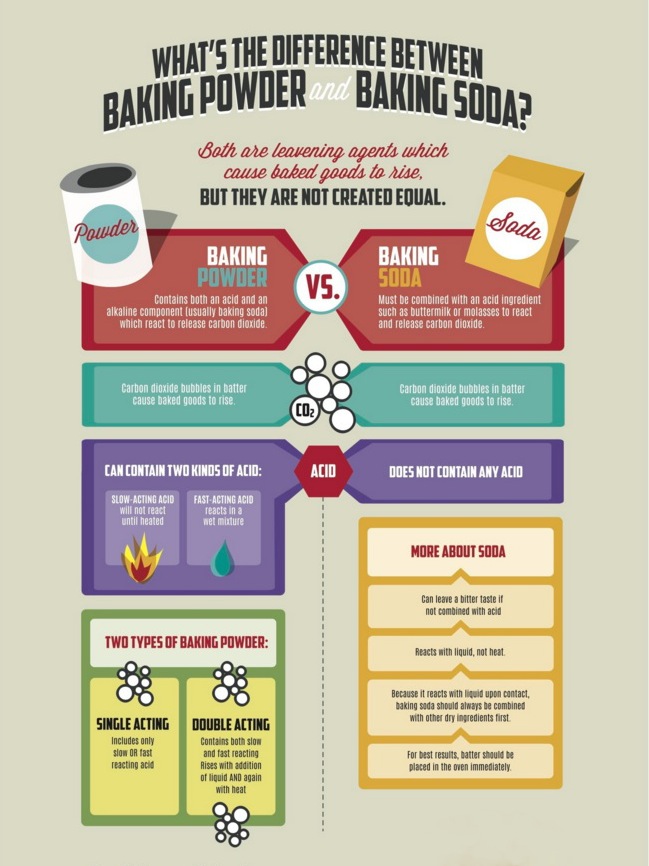 Baking soda is used in recipes that contain acidic ingredients like buttermilk, brown sugar, yogurt, lemon juice, honey, vinegar, or chocolate (except Dutch process). The acid in the recipe reacts with the baking soda, allowing your baked goods to rise. Baking powder is generally used when there is no acidic ingredient in the recipe. Bottom line: baking soda needs an acid; baking powder does not. – Jenny Jones
Baking soda is used in recipes that contain acidic ingredients like buttermilk, brown sugar, yogurt, lemon juice, honey, vinegar, or chocolate (except Dutch process). The acid in the recipe reacts with the baking soda, allowing your baked goods to rise. Baking powder is generally used when there is no acidic ingredient in the recipe. Bottom line: baking soda needs an acid; baking powder does not. – Jenny Jones
Cake Strips to the Rescue
If you bake a lot of cakes there are two issues that need fixing. One is that they rise too much in the center and the other is that the edges get over-baked and dry. A cake strip will fix that. Here is my yellow cake baked with no cake strip. It’s domed in the middle and the edges are overdone and dry.
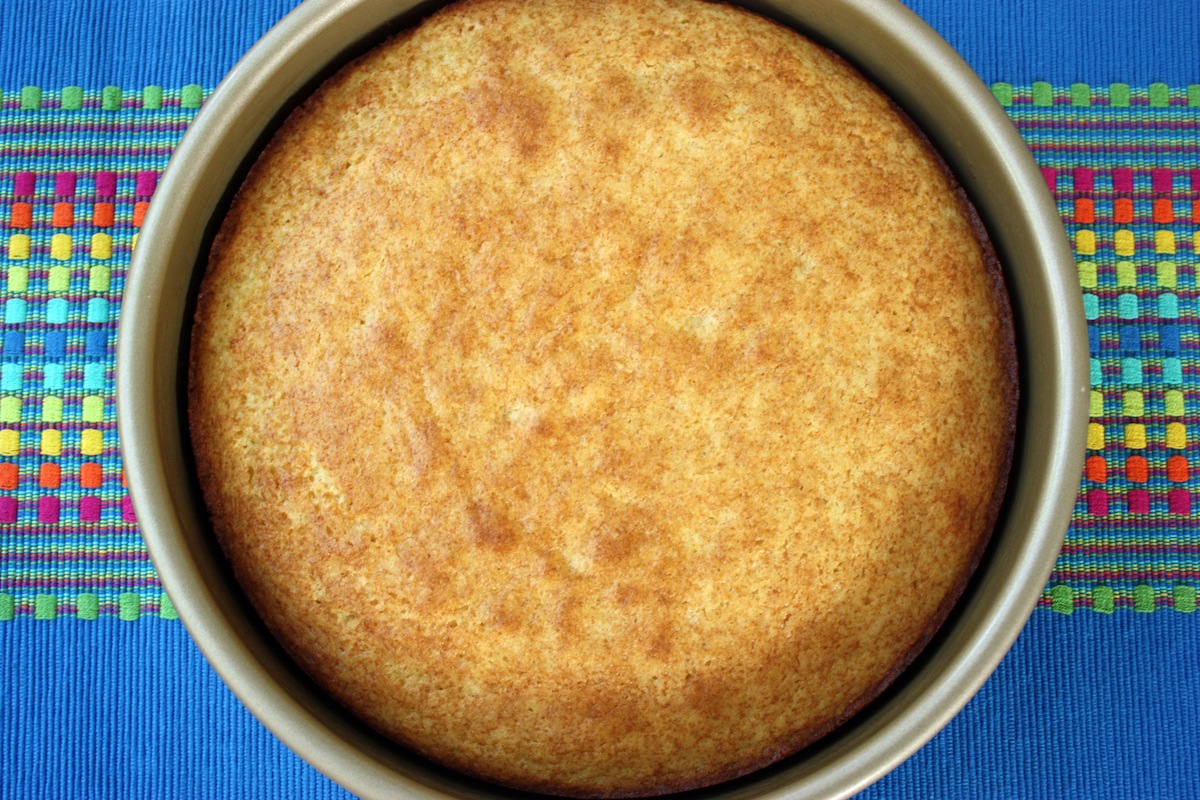 And here it is with a cake strip – perfectly flat and the edges are soft and evenly baked.
And here it is with a cake strip – perfectly flat and the edges are soft and evenly baked.
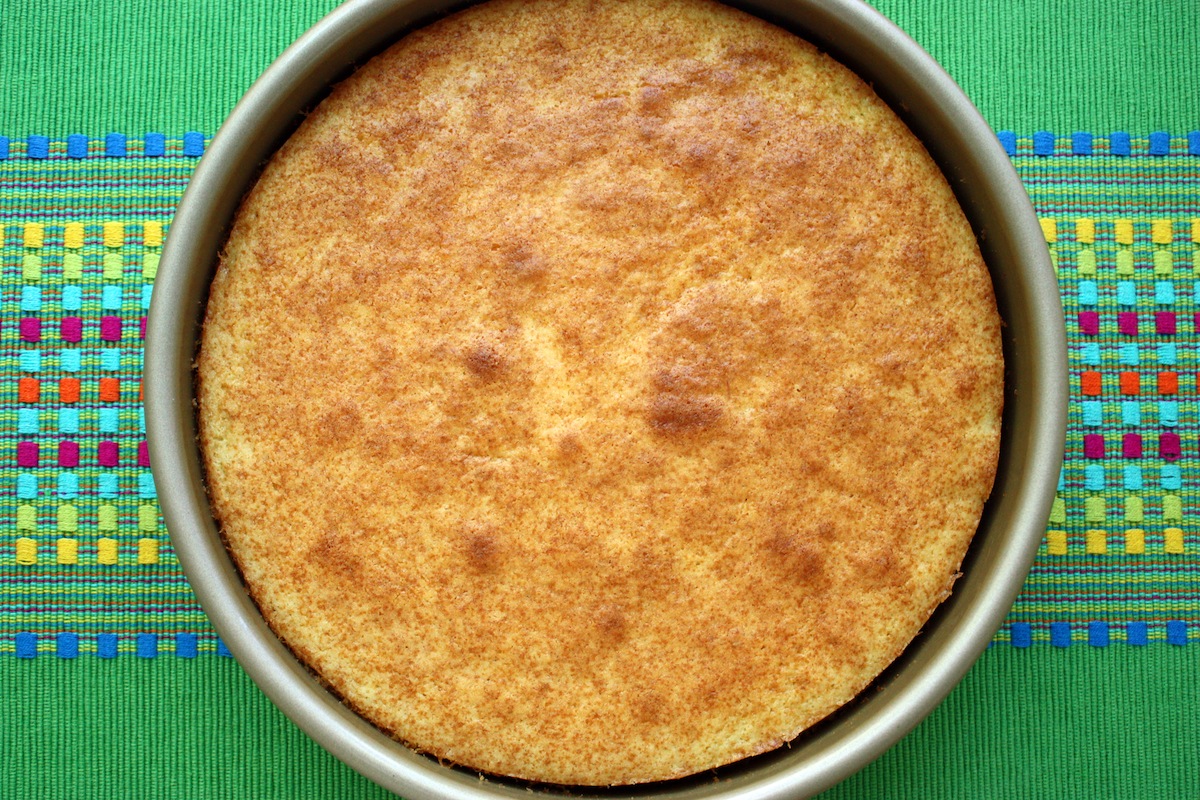 A cake strip is easy to use. You just soak it in water for about 15 minutes, then press out the excess water and wrap it around the pan just before baking.
A cake strip is easy to use. You just soak it in water for about 15 minutes, then press out the excess water and wrap it around the pan just before baking.
It protects the edge of the pan from getting too hot and the cake will bake evenly. If you can’t find one, you can fashion your own using fabric. I have never done that but you can find lots of how-to’s in the internet. They’re also called baking strips for cakes.
While working on this recipe I was surprised by something I learned about cake pans. It’s about the color. I always knew that a dark pan absorbs more heat so baked goods will brown more than in a light colored pan. But I baked two cakes, both with cake strips, in two different pans that I considered light colored. But look at the difference…
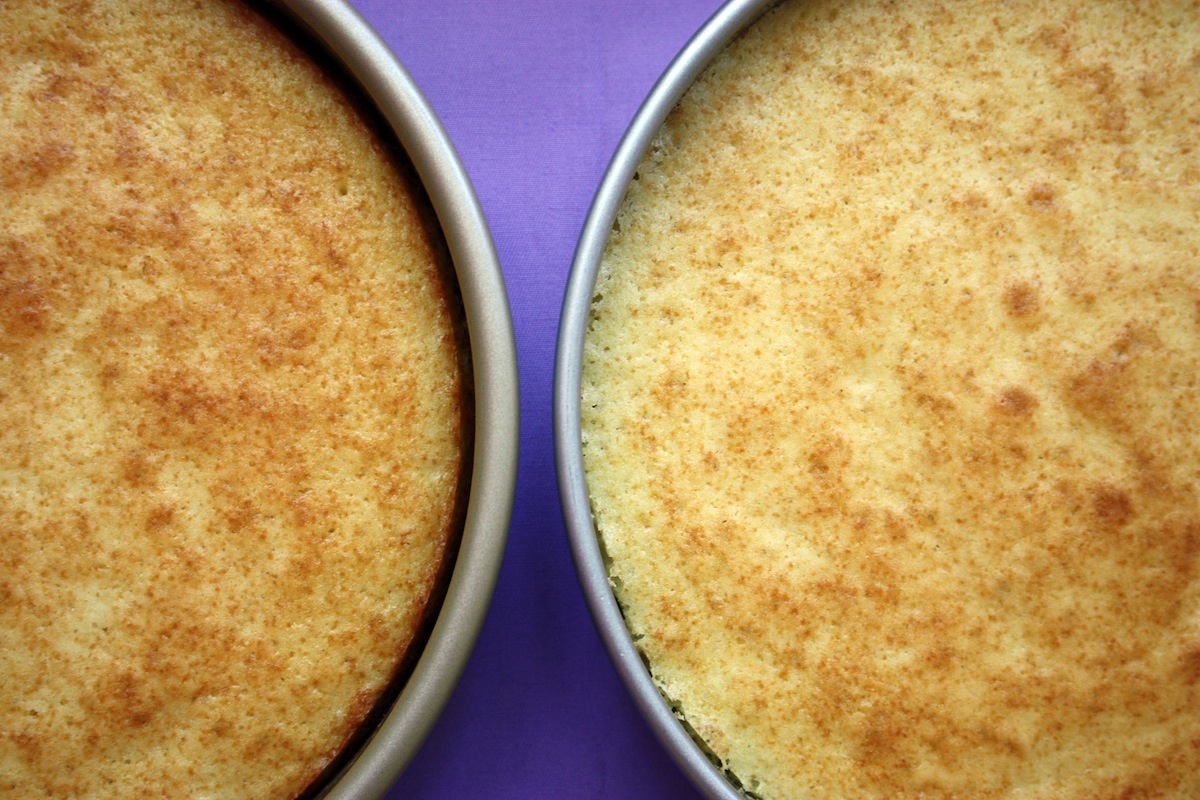 The pan on the left is my more expensive Williams-Sonoma Gold Touch pan that I never thought of as dark. The pan on the right is a cheaper silver colored pan (with no brand name so I don’t even know where I got it) but the cake in the cheaper silver pan came out perfectly. The edges were velvety soft and the cake didn’t brown too much. The one on the left was okay but the edges pulled away a bit and it browned a little more. Bottom line: use a silver colored pan and a cake strip for a perfect, soft, yummy cake.
The pan on the left is my more expensive Williams-Sonoma Gold Touch pan that I never thought of as dark. The pan on the right is a cheaper silver colored pan (with no brand name so I don’t even know where I got it) but the cake in the cheaper silver pan came out perfectly. The edges were velvety soft and the cake didn’t brown too much. The one on the left was okay but the edges pulled away a bit and it browned a little more. Bottom line: use a silver colored pan and a cake strip for a perfect, soft, yummy cake.
Speaking of cake, this simple yellow cake is one of my easy-to-make healthier cakes and it’s my go-to cake for all kinds of frosting and filling. It’s soft and not super sweet… and it’s made without butter. I’ll be posting the recipe soon, so get your cake strips ready! – Jenny Jones
